A comprehensive macaron troubleshooting guide with photos, possible causes and how to avoid the most common macaron issues!
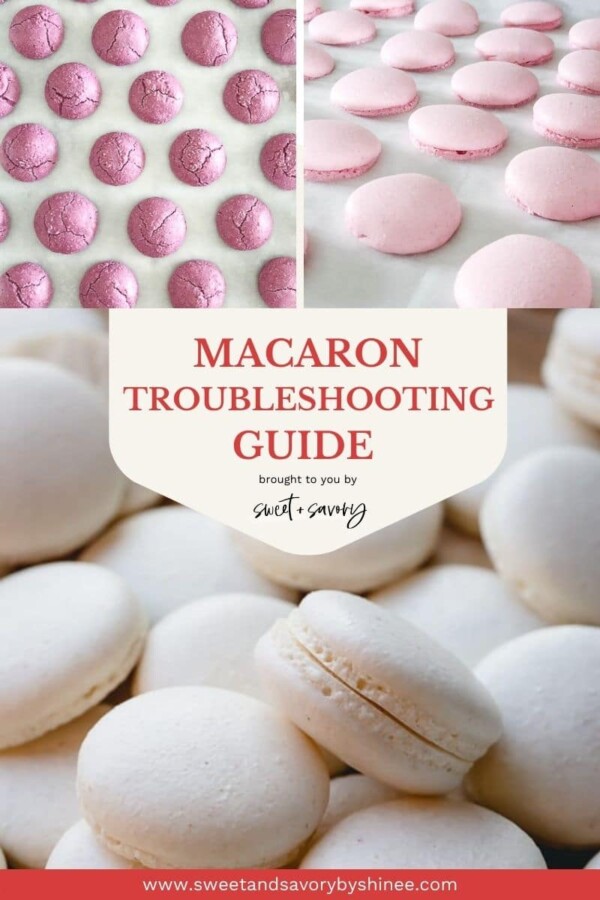
Table of Contents
Since 2012, I’ve made thousands of macarons in my home kitchen with many trials and errors, as well as picture-perfect macarons! And yes, I’ve had pretty much every problem imaginable!!
In the process, I’ve gained lots of tips and tricks to solve those frustrating issues and, most importantly, how to avoid them in the first place.
Remember, sometimes, macarons fail for no apparent reason and leave us scratching our heads.
But I encourage you to never give up on macarons. The joy of watching your macarons grow those ruffled feet and pulling out perfectly round macarons with shiny smooth tops is simply priceless.
I swear, every single time, when I see my macarons through the oven door puffing up and baking perfectly, I can’t help but do a little happy dance in my kitchen! Pure joy, I’m telling ya!
What’s a perfect macaron?
Perfect macaron is very subjective. To me, a perfect macaron has the following characteristics:
- Smooth shells
- Ruffles feet
- Full inside
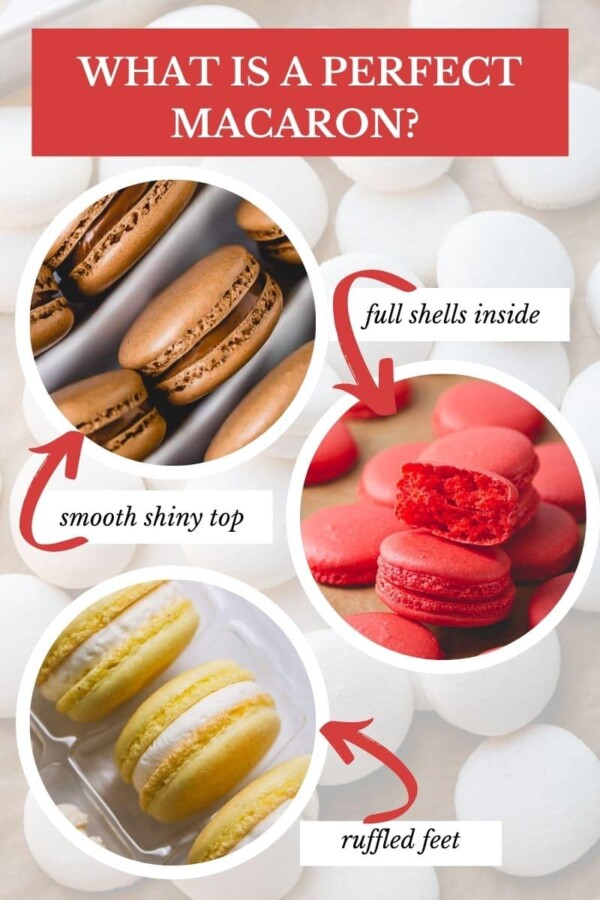
Macaron Troubleshooting Video
Visual Macaron Troubleshooting Guide
Ok, let’s discuss each of the most common macaron issues, their causes and how to fix or prevent them!
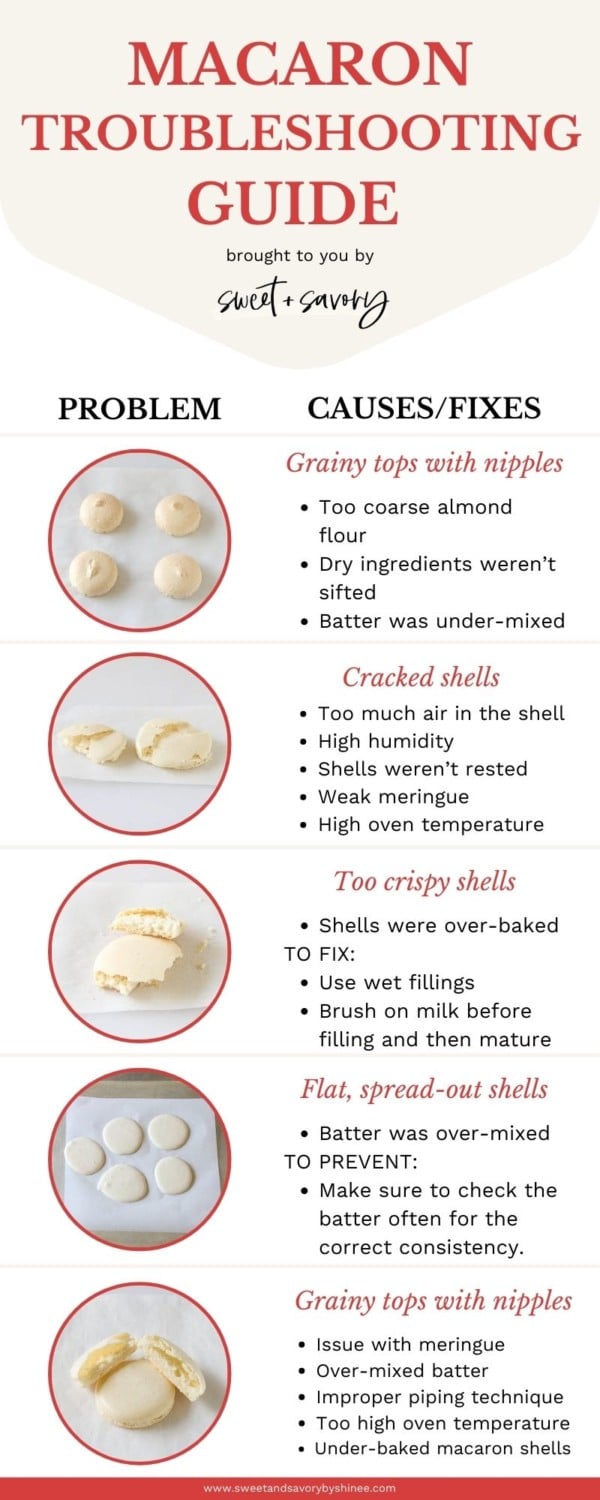
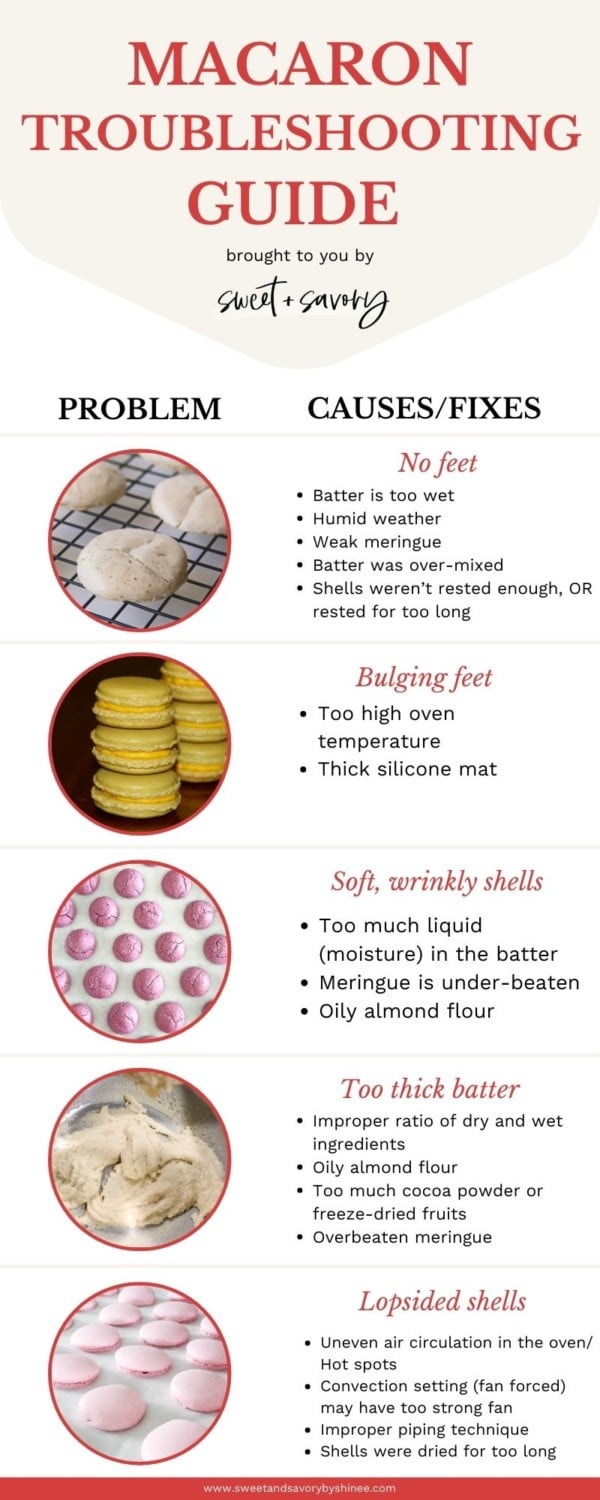
Pin this now to find it later
Pin ItUneven, grainy macarons with nipples
Possible causes:
- Too coarse almond flour
- Dry ingredients weren’t sifted
- Batter was under-mixed
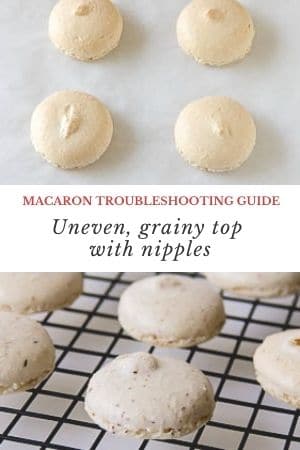
how to fix grainy shells with nipples:
- Make sure to use fine ground almond flour.
- Don’t skip sifting the dry ingredients! Toss large almond pieces left in the sifter. You shouldn’t have more than 1/2 tablespoon of almond bits.
- Under-mixed batter also causes grainy shells with nipples. When mixed right, the nipples should melt back into the batter after tapping the piped shells on the counter.
don’t do this!
Never use wet fingers to push the nipples down. Instead, use a toothpick to encourage the batter even out.
Cracked shells
Possible causes:
- Too much air in the shell
- High humidity
- Shells weren’t rested
- Weak meringue
- High oven temperature, or hot spots in the oven
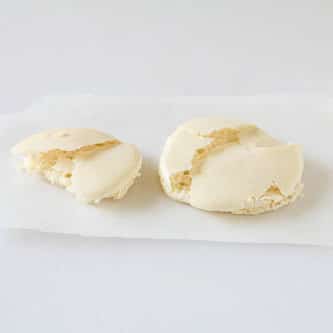
HOW TO FIX cracked macarons:
- Be sure to tap the baking sheet right after piping macaron shells. And use a toothpick to pop large air pockets visible on the surface.
- When it’s too humid, the shells don’t develop good skin, which leads to the next point.
- When the shells haven’t rested long enough to develop skin on top, steam releases from anywhere cause macarons to crack on top.
- Take your time to make nice and sturdy meringue, especially when you’re making French meringue. Watch my video on French Meringue 101 to learn all the tips to make the most stable French meringue.
- Too hot oven can also cause cracks in macaron shells. Make sure to get an oven thermometer to double check the temperature inside the oven without relying on what oven says.
Erupted shells
Possible cause:
- Touched the shells with wet finger to push down a pointy nipple
How to prevent erupted volcano macarons:
Never touch your unbaked macaron shells with wet fingers to push down pointy end. Instead tap the baking sheet well. And if the pointy end doesn’t melt into the batter, you can either baking them as is, or scrape the batter back into a bowl and mix for a little more until the batter is at correct consistency.
Too crispy interior
Possible cause:
- Shells were over-baked
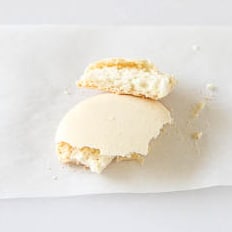
How to fix too crispy shells:
If you over-baked your macaron shells and now they’re super crispy throughout, don’t fret! 2 easy fixes:
- Use wet fillings, like jams, caramel sauce, or lemon curd in the center.
- Simply brush on milk on the bottom of the shells before piping a filling of choice.
Tip
Mature filled macarons for 24 hours. The shells will absorb the moisture from filling and macarons should soften nicely.
Flat shells, spread out too much
Possible cause:
- Batter was over-mixed
Over-mixed batter is too loose and the shells don’t hold its shape well, instead it spreads out too much.

How to prevent flat, spread out macarons:
Once macaron batter is over-mixed and it’s too runny, there’s no way to salvage it. So it’s important to prevent this from happening.
Make sure to check the batter often for the correct consistency. It should slowly run off the spatula into a ribbon, and the edges should melt back into the batter within about 10 seconds.
Hollow shells
Possible cause:
- Issue with meringue
- Over-mixed batter
- Improper piping technique
- Too high oven temperature
- Under-baked macaron shells
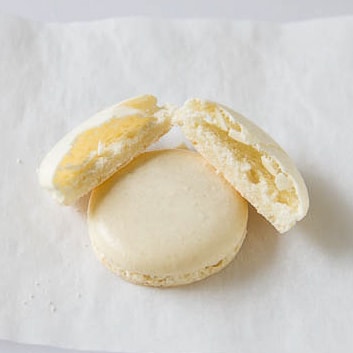
How to fix hollow macaron shells:
Hollow macarons are so common, and I personally battled with this issue for a long time. Now, I consistently get full, meaty macarons straight from the oven.
Since it’s a complex issue, I dedicated a separate post on how to fix hollow macarons.
No feet
Potential causes:
- Batter is too wet
- Humid weather
- Weak meringue
- Batter was over-mixed
- Shells weren’t rested before baking
- Shells were rested for too long, weakening the meringue structure
- Too low oven temperature
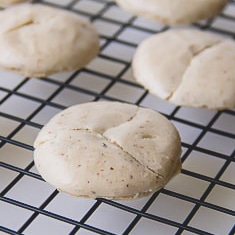
How to prevent no feet macarons:
- When the batter is too wet, macarons don’t develop those ruffled feet. The most common causes for wet batter: excess liquids, like extracts, lemon/lime juice, liquid food coloring, too much gel food coloring, etc.
- In some cases, especially in humid climates, aging egg whites might be beneficial. During aging, egg whites loose some of its moisture.
- When the meringue isn’t whipped to stiff peaks, it doesn’t have strong enough structure to lift macarons. Watch my French Meringue 101 video for visual cues for proper meringue.
- When macaron batter is over-mixed, there’s not much air bubbles left to give the shells lift during baking. Therefore, they come out flat without feet.
- Also, if macarons weren’t rested to form a skin before baking, it could cause no feet macarons. And if the shells were rested for too long, it can also negatively affect the batter, because meringue loses its stability when sat for too long. Keep checking the shells every 15 minutes and put them in the oven as soon as they don’t stick to your fingers.
- If the oven is not hot enough, macarons won’t rise as air bubbles in the meringue need heat to expand to lift the shells, creating that pretty feet at the base.
Tip
Make sure to get an oven thermometer to double check the temperature inside the oven without relying on what oven says.
Bulging feet
Potential causes:
- Too high oven temperature
- Silicone mat
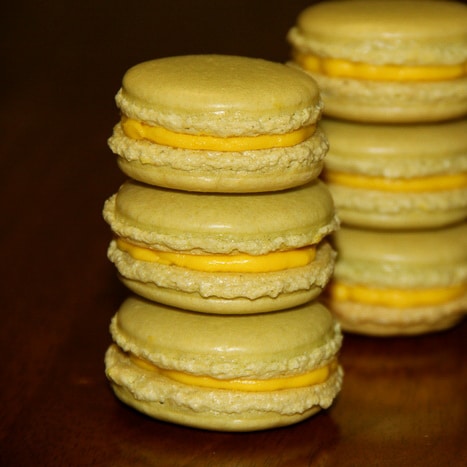
how to prevent bulging feet:
Some may find it ugly when the ruffled feet extends out of the macaron shells. I’m not a huge fan, but it’s not the worst!
- This happens when the oven is a bit too hot, causing the macarons to rise too high and then collapse slightly, making the feet bulge out.
- And another reason is silicone mat might be the culprit. I certainly happens to me with thick silicone mats, but I know some people have gorgeous macarons with silicone mats.
Soft, wrinkly shells
Possible causes:
- Too much liquid (moisture) in the batter
- Meringue is under-beaten
- Oily almond flour
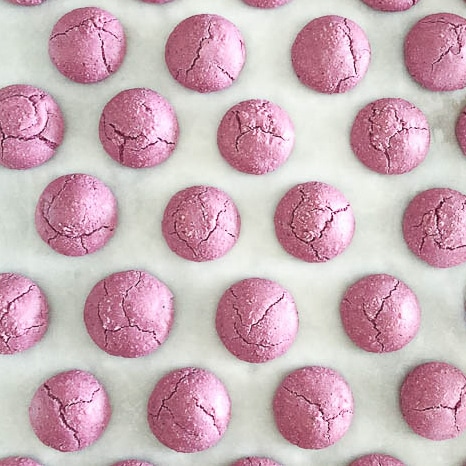
How to prevent soft, wrinkly shells:
Excess moisture and/or fat is the #1 cause for soft, wrinkly shells. And there’re number of culprits for excess moisture/fat in the batter:
- Adding liquid extracts, juices or liquid food coloring
- Adding cocoa powder, freeze-dried fruits, etc.
- Under-mixed meringue also contains too much moisture
- Oily almond flour, or almond flour that has been opened for too long
Cocoa powder contains fat which could potentially cause soft, brownie-like macaron shells. And freeze-dried fruits absorb moisture from the air fast and could cause soft, wrinkly shells as well.
Tip
Store opened almond flour in an airtight container in a cool place.
Too Thick batter
Typically, when you add dry ingredients into meringue, it starts out pretty thick and that’s totally normal. As you fold the batter, it thins out and gets runnier.
In rare occasions, the batter never loosens and it stays thick.
Possible causes:
- Improper ratio of dry and wet ingredients
- Oily almond flour
- Too much cocoa powder or freeze-dried fruits
- Overbeaten meringue
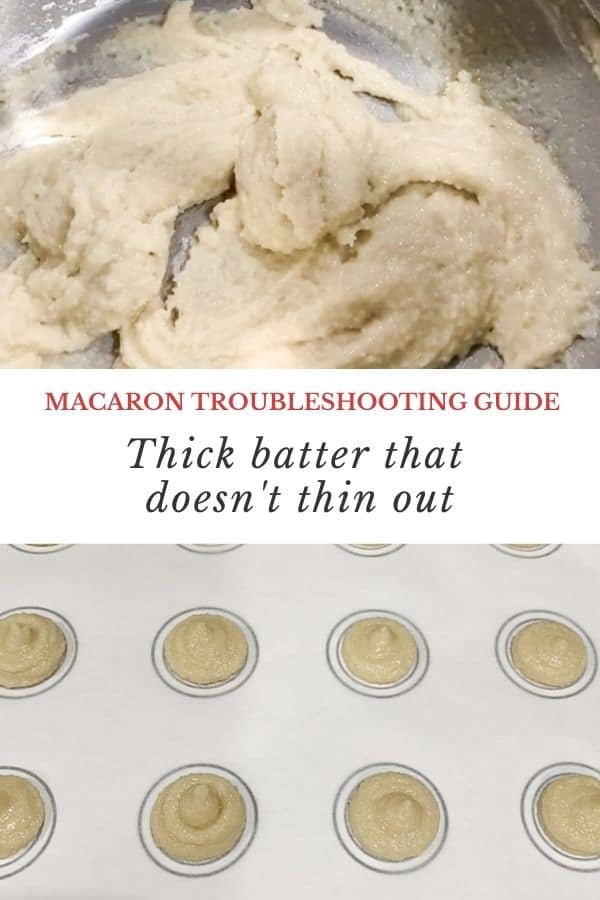
how to fix and prevent thick batter issue:
- Be sure to weigh the ingredients carefully. I strongly recommend weighing all the ingredients, including egg whites, with a kitchen scale.
- Oily almond flour could cause thick batter. Make sure to use fresh almond flour and avoid processing it in a food processor.
- Too much cocoa powder or freeze-dried fruits can throw the ratio of dry and wet ingredients.
- When meringue is over-beaten, it gets dry, throwing off the ratio as well.
Blotchy shells
I don’t have a photo of this issue, but basically it looks like greasy stains on the shells.
Possible causes:
- Oily almond flour
- Batter sat out for too long before piping
how to prevent blotchy macarons:
- Use fresh almond flour that’s not oily. To test, squeeze some almond flour in your hand and see if it holds its shape. If it holds its shape like wet sand, then it’s too oily.
- Make sure to pipe the shells right away, especially with French meringue batter.
Lopsided shells
Possible causes:
- Uneven air circulation in the oven/ Hot spots
- Convection setting (fan forced) may have too strong fan
- Improper piping technique
- Shells were dried for too long
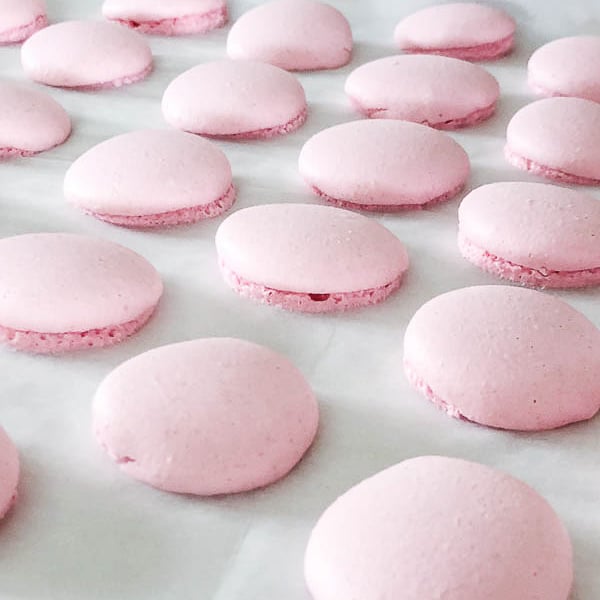
how to prevent lopsided macarons:
Main culprit for lopsided shells is poor air circulation. This could be due to uneven heat distribution and hot spots in the oven, convection settings with too strong fan. Here’re a few things you can do in this case:
- Flip the baking sheet upside down before piping macarons, so that there’s no edges around the sheet to block any heat circulation.
- Bake macarons one sheet at a time.
- Turn the baking sheet around half way through baking.
- If possible, bake on conventional setting, heat coming from top and bottom.
The next reason for lopsided macarons is improper piping technique. Pay close attention to following:
- Hold the piping bag with macaron batter straight at 90° and squeeze the batter from the top to one spot until the desired size reaches. Watch my macaron video for better illustration.
- Pipe the shells at least half an inch apart to give the shells enough room for air circulation.
And lastly, don’t dry your macarons for too long. Too thick skin may cause lopsided macarons.
Concaved (Inverted) shells or Stuck To Parchment
Possible causes:
- Low oven temp/ low heat from bottom
- Under-baked shells
- Not cooling the macarons before removing from parchment paper
How to prevent concaved, or stuck macarons:
- Make sure your oven is hot enough. Most of the time, ovens need good 30-45 minutes to preheat properly. Even if it beeps when it’s preheated, I highly recommend double checking with an oven thermometer.
- Be sure to check the macarons for doneness before taking them out. To test for doneness, gently touch the top of one macaron with your index finger and try wiggle it. If it wobbles side to side, they’re not ready. keep baking for another minute or so. The cooked shells should wiggle ever so slightly and firm to touch. When in doubt, cook a bit longer. In my opinion, it’s better to over-bake them than under-bake them.
- Make sure to cool the macarons on the baking sheet for at least 10 minutes before removing from parchment paper/silicone mat.

Whew, are you still with me? Thank you!!! I hope this macaron troubleshooting guide answers your questions and helps you to perfect your macaron skills.
And if there is anything I haven’t covered, please leave me a comment below. I’d like us, macaron-lovers, connect and discuss various problems we face baking macarons. Let’s get the discussion started.
More Favorites from Sweet & Savory
This post was originally published on December 21st, 2015, and last updated on February 16th, 2021.



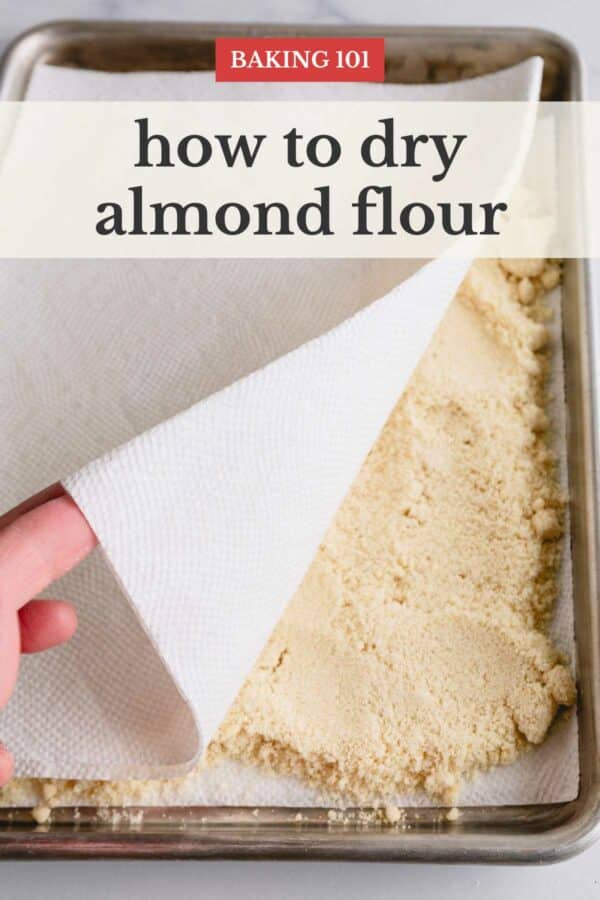


Hi! When I try baking macarons my shells end up very hollow, with fragile tops that break easily, feet that wont stick to the shell, and raw bottoms with tops that brown quickly. I’m using an oven thermometer so i know i’m using the right temperature recommended. I use a stand mixer as well but i always make sure that i beat my egg whites to stiff peaks. My feet can sometimes over develop quickly after a 5 minutes in the oven. Do I need to lower my oven temperature? Do I need to put my macarons on a lower rack? Am I folding the batter wrong? They taste delicious though. Thank you!
Hi, Annika. Thank you for reaching out and for all the details you’ve provided. It sounds like your oven heats more from the top. But quick question. Do you use parchment paper or silicone mat? If you use silicone mat, have you tried parchment paper instead? Silicone mat transfers heat slower, so that may be the reason why the macarons are cooking slower on the bottom. Also another suggestion is to place the oven rack with macaron tray one shelf lower, and another rack on the very top shelf and place an empty baking sheet on the top rack, so that it’ll shield the heat from the top. Does that make sense? Let me know if you have any other questions. Good luck!
Hi! I am about to make macarons tonight and tomorrow for a party. What do you think about not serving them fresh right after you fill them? I’ve read that some people let them sit for 24 hours first on purpose. Have you heard of that?
Hi, Rachel. You can totally make the macarons 1-2 days in advance. You don’t have to serve them fresh. In fact, you read it right, some people recommend to mature the macarons for up 48 hours so the shells get softened and absorb flavors from the filling. Also, most filled macarons freeze pretty good. 🙂 Good luck!
Hello, I have made soooo many batches of macarons and have finally gotten them to look absolutely perfect but cannot get past the hollow issue. They have smooth tops, ruffled feet, beautiful color. But no matter what they are hollow. I cannot figure out if it is the meringue or the oven temp is too high.I have an over thermometer and are baking them at 300 degrees. Is it possible for the oven temp to be the culprit . Also I notice that when I am piping ther are lots of air bubbles. Of course I always rap the sheet pan and pop them, also use a toothpick to get the rest. Just want sure if maybe I am not removing enough air in my batter during macaronage. Please help lol I am so close to perfection.
Hi, Jhanese! So happy to hear you’re almost there to perfect your macarons. And I think it’s a very common problem. I also remember having the same problem as you. If the macarons are not browning too much too quickly, I think oven temp might be ok. But I always recommend getting an oven thermometer to double check. Most common culprit for hollow macarons is over-beaten meringue. Are you using stand mixer? It’s very easy to over-mix the meringue in a stand mixer, so I suggest checking on it frequently, and not to beat at too high speed for too long. I like to gradually increase the speed and gradually decrease the speed when beating the meringue white. Hope you can fix the hollow issue and you’ll get your perfect macarons soon. 😉
How can I tell when my macarons are finished baking?
Hi, Diane. If you try to carefully lift one macaron, it should peel off nicely. If the bottom is stuck and the top shell separates from the feet, they’re not done yet.
Hi,
So I have made macarons three times, the first two times they came out very good, nice macarons, good feet shiny top. This time however they really didn’t rise to get that nice pillow top. They are kind of flat but still have good feet and a good shiny top. Did I maybe not beat the whites long enough? I think my peaks may have been a little soft. Could have have caused them to not rise as much?
Hi, Mike. That may be the culprit. You do want your meringue with nice hard peak, or else they may come out with soft, wrinkly shell. But in your case, it may have been underbeaten just a little. Also did you use the same recipe as the previous 2 times?
Hi,recently I had a problem while baking macarons.I baked them at 300 F for 20 mins.They looked perfect while baking,nice feet formed.But as soon as I removed the tray from the oven they collapsed.What did I do wrong? Please help.
Thanks.
You have to leave the macarons in longer for a few minutes or so to cool and set completely. If you open the oven before they are set, it will collapse the inside. (Outside is already set so it stays unchanged). If they brown, I recommend cooking them at lower temperatures for a longer time. 🙂
Kaylen, I was thinking the same. Thanks for chiming in!
Bonjour,il faut sortir les macarons du four dès qu’ils sont cuit et les poser sur le plan avec seulement le papier cuisson .si on laisse sur la plaque du four ils continuent de cuire😉
Hello, we must take out the macaroons from the oven as soon as they are cooked and put them on the plan with only the baking paper. If we leave on the oven plate they continue to cook
And thank you for these delicious recipes.
Merci for the tip, Lilli!!
Hi, Amera. It’s hard to say exactly what was the reason. The reason may be they were underbaked. But can you give me a bit more details? Was it first time you tried that recipe? Which recipe was it? Do you have an oven thermometer to check the actual oven temperature? Were these your first time making macarons? Or were you able to bake perfect macarons before?
Hi! I’m always turning up with hollow macarons every time I bake them! And I cook them at 300 F but unless they start to brown, they don’t come off the baking sheet! So they always lose colour… what should I do?
Hi, Jenny. To fix hollow issue, try beating the egg whites for a little less time, just until it reaches stiff peaks. Over-mixed meringue can be a culprit for hollow macarons. For browning issue, try placing an empty rack at the very top shelf and place another empty baking sheet to shield the macarons from heat from above. Also, if you don’t have oven thermometer, I highly recommend getting one to monitor the actual oven thermometer. Your oven may run a bit hotter. Hope this helps, let me know.
Would love some advice or help! My macarons are all lopsided, I’ve had better success with the French method than this batch when I tried the Italian meringue method. I tried convection on, and off, I let the shells dry almost an hour before baking, the oven temp was 300° F, not sure what to do? I’ve read so many blog posts and tried different things but I still get the same result. Shortly after putting them in the oven, the tops crack and goop comes out the top where the crack is…any advice?
Hi, Lena. Thank you for reaching out. For your issue, I’d turn the fan off. Also do you have an oven thermometer in the oven, or are you going off the oven settings. If you haven’t already, I highly recommend getting an oven thermometer, like this one, to monitor the accuracy of the oven temp. Usually the lopsided macaron issue that you had described is caused by too hot oven temperature.
Thank you for your suggestions! I did try a batch without the fan, and they were still lopsided. I’m using a brand new oven so I thought the temperature would be pretty accurate still, but I’ll try reducing the temp.
Yeah, I would definitely get an oven thermometer in your case, so that you can check how your new oven works. And let me know if lower oven temp helps. Thank you!
I too had same problem then I started heating my oven at 200 Only bottom no top heating then put the macroon inside after they delovoped feet I lowered the temp to 130 and altogether baked for 20 min now my almost all the batches comes out perfect even with pumpkin seeds instead of almonds
Hi, Supriya. Thank you for sharing your experience. So helpful! One question… Are you talking oven temperature in Celcius or Farenheit?
I have made macarons a couple of times with great success, but something went wrong this time. I got a nice smooth exterior, and nice ruffled feet. They looked perfect, but browned just slightly. The bottom was lightly crisp, but the interior was hard and chewy, not soft and chewy. What went wrong? I was so disappointed.
I have made these macarons several times with beautiful results…. however, this year has been a different story. For some reason, it does not matter how much I fold the batter, it does not loosen up. The batter simply stays thick. The resulting macarons have no feet and are cracked all over the top. The only item I’ve changed is the almond flour, but that shouldn’t really matter should it? Any advice? Thanks.
Hi, Rick. The type of almond flour can definitely be the problem. One of my readers reported that when she changed the type of flour she no longer had thick batter issue. What kind of almond flour did you have a problem?